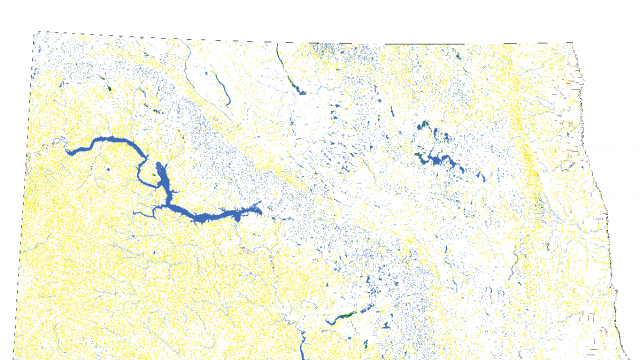These Maps Illustrate Why The EPA's New Waters Of The U.S. Rule Is So Scary

“North Dakota’s congressional delegation isn’t happy about a new rule finalized by the Environmental Protection Agency today,” reports Mike Chaussee for KXNet. “Senator Heidi Heitkamp says she’s frustrated. Senator John Hoeven says he’s concerned. And Representative Kevin Cramer calls the decision disturbing.”
But if you haven’t been following this issue you may be wondering why there’s so much bipartisan consternation over the rule.
The map above is, I think, the most succinct explanation for why the Waters of the U.S. rule is such a big deal. The map was released to Congress when the House Committee on Science, Space and Technology (of which Rep. Cramer is a member) investigated the matter. It was a bit of a fight for Congress to get the EPA to release the information.
You can see the map for North Dakota above (high-res version here).
Lakes are in dark blue. Streams and rivers are in light blue. Intermittent bodies of water are in yellow. Obviously, all that yellow is a concern.
Even more troubling is a second map for the EPA’s 8th region, which includes North Dakota. It depicts the “water inventory” for each state. As you can see, pretty much the entire state of North Dakota is colored in blue.
If that’s indicative of what the EPA plans to regulate in North Dakota, it’s hard to imagine what can be done in the state – from construction to energy development to agriculture – without going through the EPA.
Which, no doubt, is the point.
“It is certainly alarming the EPA would develop these maps in secret and only release them after being confronted by members of Congress,” Rep. Cramer said of the maps in a press release sent out in August of last year. “The EPA has been hiding information which could upset the public and jeopardize its massive power grab of unprecedented authority over private and public water. It doesn’t take much of a leap to conclude these highly detailed maps developed with taxpayer funds are for the purpose of enforcing this rule.”
That’s the problem. This rule is so fantastically broad that it amounts to a sort of takeover.




